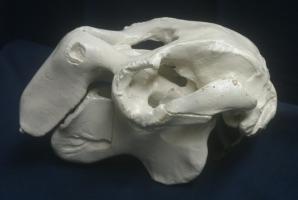
ORDER SIRENIA: THE DUGONG AND THE MANATEES.One of two fully aquatic ungulate orders. The manatees inhabit the large rivers and Atlantic coastal waters of tropical Africa and America. The dugong is found in the south-west Pacific and Indian oceans - mostly in coastal areas but often in deeper waters. Sea-cows have few competitors for their sea-grass diet, perhaps turtles, but the silicate in their diet forces the sea-cow to constantly replace its teeth. A very slow metabolic rate permits submergence for long periods. Their flippers and fluked tail are used for locomotion. Today, sea-cows are threatened by hunting, pollution and collisions with boats. Amazonian manatees are being used to manage excess water weeds from dammed lakes which prevent navigation, block turbines and destroy fisheries. Perhaps the future is not so dim for at least some of the Sirenia.
The only front teeth on the skull of dugongs are a pair of tusks (incisors). The remaining teeth are all set far back in the jaw. The mouth opens on the underside for easy grazing. The jaw of the manatee is less angled, and the teeth are constantly replaced from the back of the jaw (as in elephants). The dugong is a shy, poorly known creature. The only true sea-going herbivore, Dugong travels in groups from a single cow and calf to several hundred animals.
SIRENIAN EVOLUTION & THE 'TETHYTHERIA' The earliest sea-cows are found in Eocene deposits around the Tethys Sea (between Africa and Eurasia), where they fed on the seagrass that grew in the tropical waters. From here they spread as far as the Carribean and the Pacific Strange as it may seem, the closest relatives of the sirenains are the elephants. The Proboscidea and the Sirenia are united by morphological features and protein/DNA sequence studies The Orders Proboscidea and Sirenia are united in the taxon 'Tethytheria'. |







